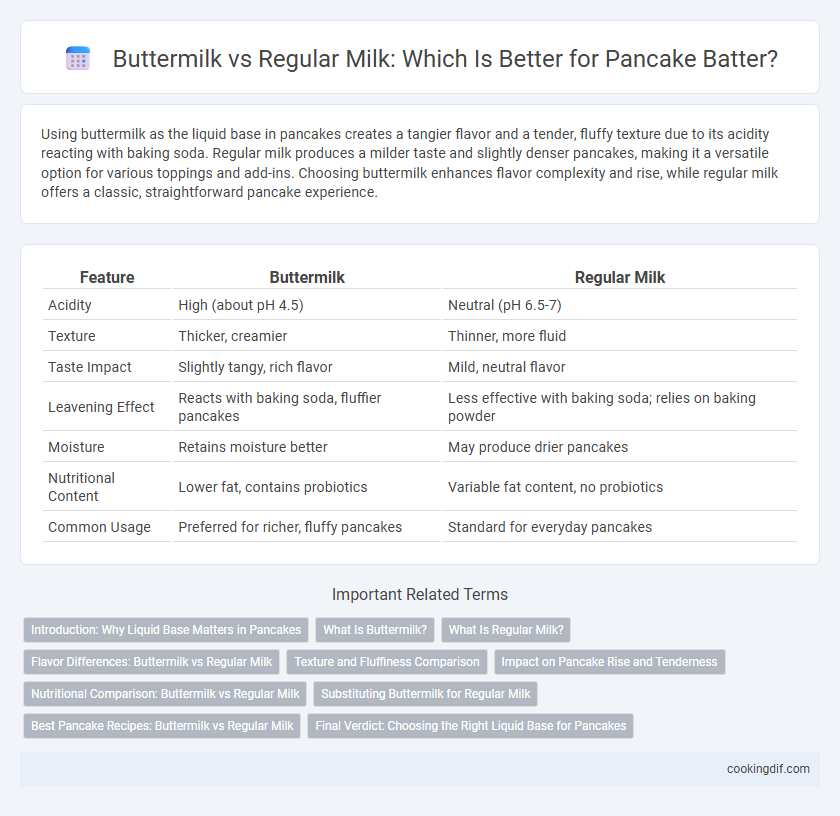Using buttermilk as the liquid base in pancakes creates a tangier flavor and a tender, fluffy texture due to its acidity reacting with baking soda. Regular milk produces a milder taste and slightly denser pancakes, making it a versatile option for various toppings and add-ins. Choosing buttermilk enhances flavor complexity and rise, while regular milk offers a classic, straightforward pancake experience.
Table of Comparison
| Feature | Buttermilk | Regular Milk |
|---|---|---|
| Acidity | High (about pH 4.5) | Neutral (pH 6.5-7) |
| Texture | Thicker, creamier | Thinner, more fluid |
| Taste Impact | Slightly tangy, rich flavor | Mild, neutral flavor |
| Leavening Effect | Reacts with baking soda, fluffier pancakes | Less effective with baking soda; relies on baking powder |
| Moisture | Retains moisture better | May produce drier pancakes |
| Nutritional Content | Lower fat, contains probiotics | Variable fat content, no probiotics |
| Common Usage | Preferred for richer, fluffy pancakes | Standard for everyday pancakes |
Introduction: Why Liquid Base Matters in Pancakes
The choice between buttermilk and regular milk as a liquid base significantly affects pancake texture and flavor. Buttermilk's acidity reacts with baking soda, creating a fluffier, tender crumb, while regular milk yields a milder taste with a denser texture. Understanding this difference helps optimize the perfect pancake batter for desired softness and richness.
What Is Buttermilk?
Buttermilk is a fermented dairy product rich in lactic acid bacteria, giving it a tangy flavor and thicker consistency compared to regular milk. Its acidity reacts with baking soda in pancake batter, producing carbon dioxide that helps pancakes rise and become fluffier. Using buttermilk as the liquid base enhances texture and imparts a subtle tartness, differentiating it from the neutral taste of regular milk.
What Is Regular Milk?
Regular milk, often referred to as whole or skim milk, is cow's milk that has undergone minimal processing and retains a natural balance of water, fats, proteins, and lactose. It provides a neutral flavor and moderate acidity, making it versatile for various recipes, including pancakes. Unlike buttermilk, regular milk lacks the tangy taste and higher acidity, which impacts the texture and rise of pancake batter.
Flavor Differences: Buttermilk vs Regular Milk
Buttermilk imparts a tangy, slightly acidic flavor to pancakes, enhancing their depth and richness, while regular milk offers a neutral, mild taste that lets other ingredients stand out. The acidity in buttermilk reacts with baking soda, producing a tender, fluffy texture alongside a subtle tang. Regular milk lacks this acidic component, resulting in pancakes with a more classic, straightforward flavor and a less tender crumb.
Texture and Fluffiness Comparison
Buttermilk enhances pancake texture by reacting with baking soda to create air bubbles, resulting in a lighter, fluffier consistency compared to regular milk. Its acidity tenderizes gluten, yielding softer pancakes with a delicate crumb. Regular milk produces denser pancakes with a thicker texture due to the absence of this acidic reaction.
Impact on Pancake Rise and Tenderness
Using buttermilk as the liquid base in pancakes enhances rise and tenderness due to its acidic nature, which reacts with baking soda to produce carbon dioxide bubbles that help the batter expand and become fluffier. Regular milk lacks this acidity, resulting in less leavening action and a denser, less tender pancake texture. The lactic acid in buttermilk also breaks down gluten more effectively than regular milk, contributing to a softer crumb and improved mouthfeel.
Nutritional Comparison: Buttermilk vs Regular Milk
Buttermilk contains fewer calories and less fat than regular milk, making it a healthier choice for pancake batter. It is rich in probiotics and provides higher levels of calcium and vitamin B12, supporting digestion and bone health. Regular milk offers slightly more protein but lacks the beneficial lactic acid bacteria found in buttermilk, which can enhance the pancake's texture and flavor.
Substituting Buttermilk for Regular Milk
Substituting buttermilk for regular milk in pancake recipes enhances flavor and texture by adding a tangy taste and creating a tender crumb. Buttermilk's acidity reacts with baking soda, producing carbon dioxide that results in fluffier pancakes with superior rise. When swapping, use an equal amount of buttermilk or add 1 tablespoon of lemon juice or vinegar to 1 cup of regular milk to mimic buttermilk's effects.
Best Pancake Recipes: Buttermilk vs Regular Milk
Buttermilk enhances pancake recipes by providing a tangy flavor and tender texture due to its acidity, which reacts with baking soda to create a fluffy rise. Regular milk offers a neutral taste and lighter consistency but lacks the acidity needed for optimal leavening, resulting in denser pancakes. For best pancake recipes, buttermilk is preferred for its superior moisture retention and elevated fluffiness compared to regular milk.
Final Verdict: Choosing the Right Liquid Base for Pancakes
Buttermilk creates fluffier, tangier pancakes due to its acidity reacting with baking soda, while regular milk produces a milder flavor and lighter texture. For recipes requiring a rich, tender crumb and enhanced rise, buttermilk is the preferred liquid base. Choosing buttermilk boosts both flavor depth and pancake fluffiness, making it the ideal choice for classic breakfast stacks.
Buttermilk vs regular milk for liquid base Infographic

 cookingdif.com
cookingdif.com